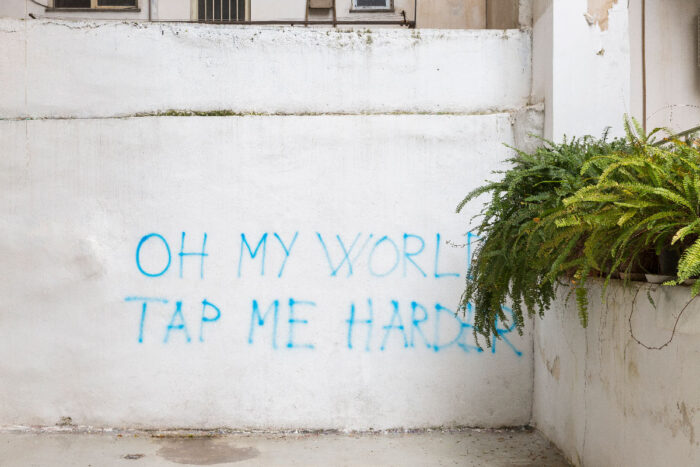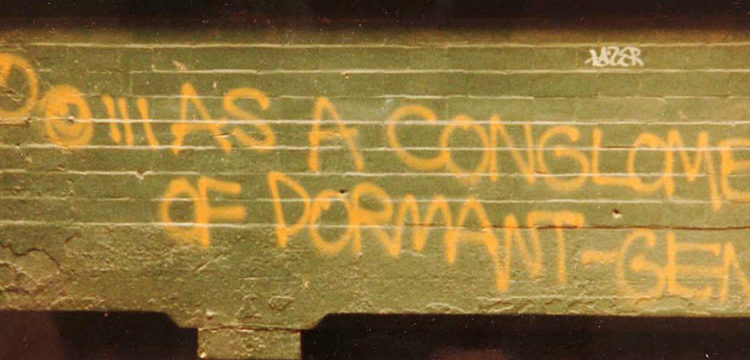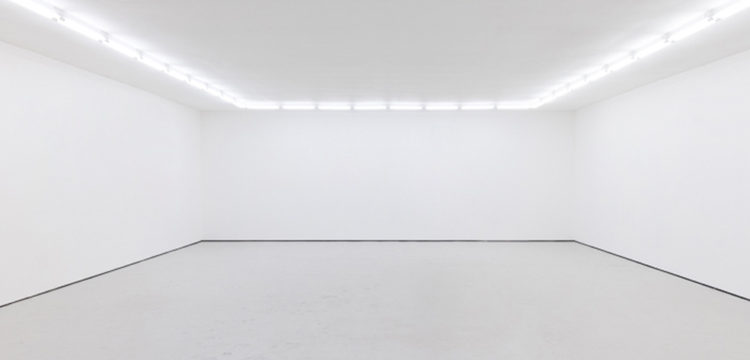A Guided Tour
To “Phasmic Erratic Theory”
Phasmic Erratic Theory is a solo exhibition by Young Agamben at P.E.T. Projects, Athens, that ran from 22 March to 9 June 2023. Here an essay by the artist.
This is where I post from. The “I” is a citation, a reference, a mention, a result in the search bar. I am we. The admins are elliptical curves traversing the socnet graph, psychometrical classifiers, optimization functions, Bayesian hallucinations. Somewhere the Theoretical Autonomous Zone emerges, a jazzy nook infused with the electrical perfume of the immortal rose of the intellect, VR petals downloading 1080px velvet electroilluminations drew by foretelling schizoscribes. The ThAZ flickers with self-consciousness, then it phasms out amidst an ordeal of fetishistic illustrations. The ThAZ is the peak and the nadir of a wave called the asyncronicity of the automaton. Everything else is cold concrete floor scattered with insecticidal liquid flowing towards the drainage hole. Narcissistic ruminations. Affliction and exaltation. The energy assembled by the global dynamic of the food chain is redirecting itself from maintaining, reproducing, and expanding the space occupied by homeostatic volumes (aka biological forms) towards their perennialization. The Sun gazes with the grin of Medusa. Mineralization: God equals extinction. Homeostasis appears to be the real subject of history, civilization is nothing, but a contemplating machine aimed at foreverness, a dispositive which breeds passions and affective tasks as a firework spectacle, a cornucopia of diversions. In the end, the real exegesis of energy flows is the only task left to philosophy.
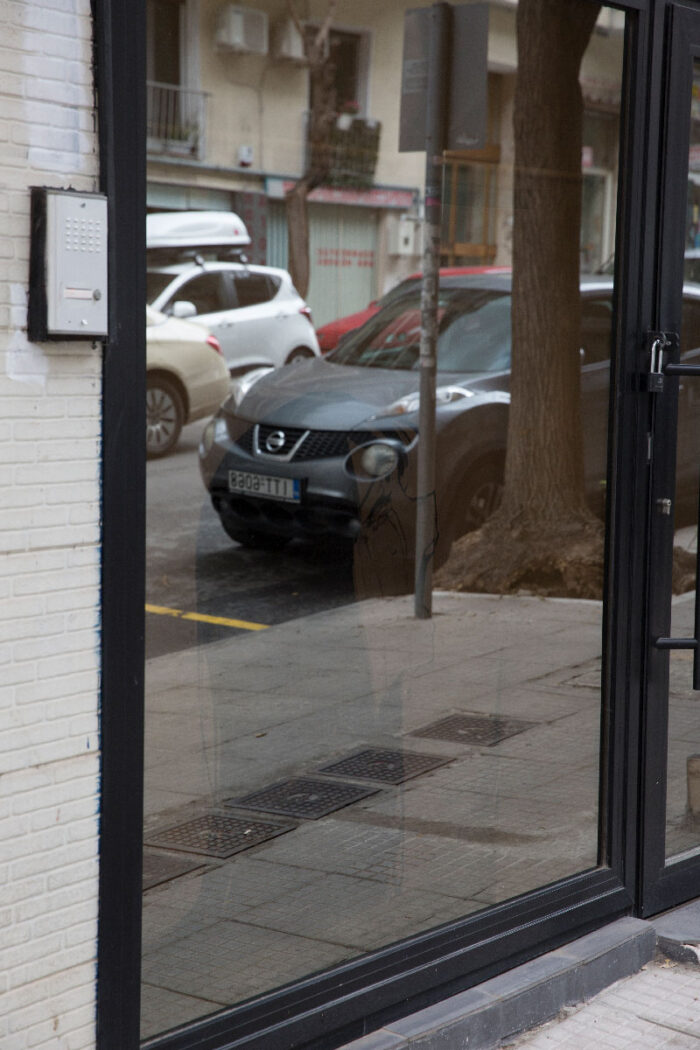
Signs circulate in vertical cascades of affects. Behavioral microloopholes, psychionic darts. The weekly algo contest points towards the profile of the e-maenad, the cannibal hypergradiva. As always, it is unclear whether she cries out of desperation or joy: the highest and the lowest of passions, the most public and the most private, flare together. Dancing under the gaze of Heraclitus and Democritus, she mourns the universe while fucking it. «It is curious to observe, and it is certainly true, that the extremes of contrary passions are, with very little variation, expressed by the same action» says Reynolds in his manual. Then comes this series: Darwin, Warburg, and Wind. ( ͡°( ͡° ͜ʖ( ͡° ͜ʖ ͡°)ʖ ͡°) ͡°). Are pathosformeln travelling from Euripides to your feed? The young girl comes from Japan and Ancient Greece, the two lores judged by Madonna California holding the balance and the sword. Mimetic vertigo, emanative sublime: the propagation of forms through millennia seized by this same paragraph.
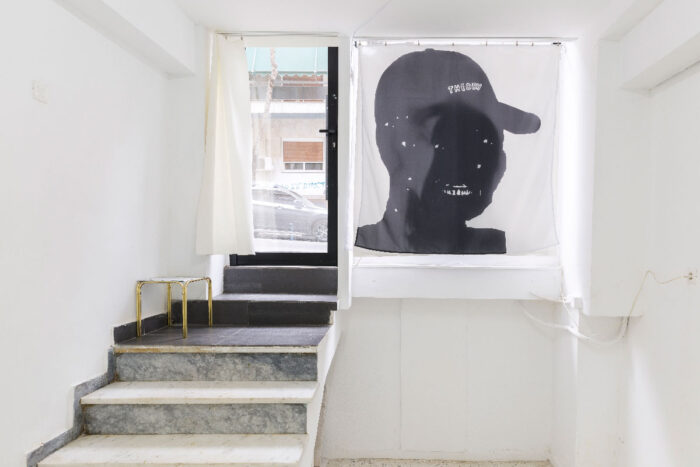
Images are no longer just enslaving humanity as ideology, they are also burning it, forcing the migration of the singularity to silicon and metal. This happens because the need of producing resource-consuming screens (sign-bearing framed surfaces) has reached the point of no return. Everything happening now happens in function of the reproduction and multiplication of screens. As this activity generates an increasing quantity of human labor, screens engender and inflate biocapital. The production and the technological improvement of screens seems to be the telos of humanity: the increasing presence and power of screens push their subjects to live either as managers and accountants of reality or as manufacturers of unreality. You work in front of a screen. If you don’t work in front of a screen, you will look for a screen in the moment you pause or end your work. The activity you conduct without the screen is false; the activity you conduct with the screen is true. You carry a screen with you, you are pregnant with signs. Human praxis must be understood from this point of view. The screen affords expression and control. Society shall be defined as the collective coordination of the movement of bodies operating the tendential augmentation of the technical capabilities of screens: resolution and portability. Any ecological problem is a problem in the general economy of the bodies: what the bodies do of their energy, their collective dynamis. The evolution of screens in time dictates the configuration of life, the mode of production, not the contrary. From prehistoric caves to the future neuroVR nexus, screen performativity, that is the amount of storable information and operational affordances distributed in within a frame, is the focus of technical action. There is an interest to build worlds inside screens, but the supreme desire is to transform the world itself into a screen; that is, a neutral computable surface whose reality-making capabilities defies the rules of spacetime. Screens are watery stargates. Water is the elemental manifestation of virtuality because its shapeshifting matter accounts as the figure of possibility itself.The cloud, the stream, the torrent, the deep, to navigate, to surf, to dive: cybermeteorological metaphors celebrate the superplasticity of the virtual and hide the uncoscious and inherently anglosaxon oceanic crowd crystal identified by Elias Canetti. Heidegger said: «Higher than actuality stands possibility». Is this why we are striving to be submerged? In ancient mythology, the Deluge terminated a calendric cycle and initiated a new aeon. The cosmogonical effort to build surfaces which let humans escape their formless surroundings (the Titans) for the time their attention is grabbed inside the computable controlled space framed by the temple of the screen (Athena) implies the obliviousness of the rest of the habitat. In the history of the species, the current generalization of screen-gazing, a specific historical configuration of the sensorium, brings about the acceleration of the ecological catastrophe in force of the trend in the economics of attention characterized by this diversion which speeds up the schizoid displacement of the Da from the sein. Notwithstanding the power of the holographic machinery, Paradise has no place in this world. The Avatar knows. A grinning character constellated with eyes is held together by a screenburnt black skin. This expelled Adam lacks in sight although it did everything it could to grow an angelic quantity of perceptrons. Its fancy baseball cap is not enough to protect it from the onslaught of light.
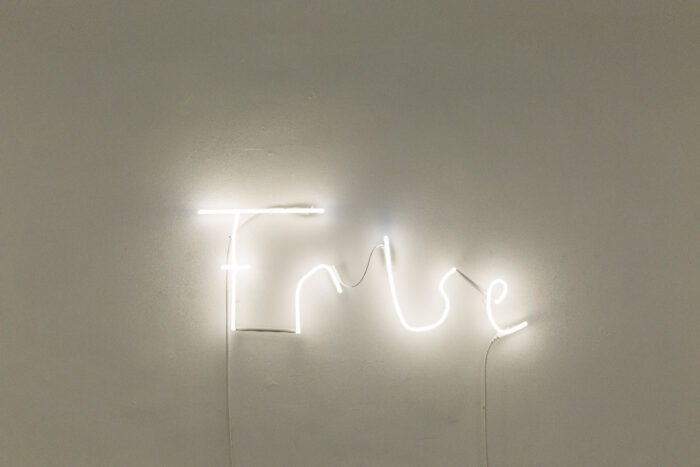
Most contemporary signs appear on the surface of retro illuminated screens. Contrarily to their nonelectrical peers, they are not visible in force of the light that illuminates them, rather, they generate light, they are light. These signs do not need the consumption of an external energy resource to access visibility (hydrogen in the case of light coming from the Sun), they are this same consumption. As much as they refer the world, they munch it. The development of generative imaging and LLMs marks the entrance of screens into the epoch of the critical indiscernibility of their content. The coming cataclysm concerns also the increasing volume of circulating signs. Post-truth refers less to the injection of false information in the public sphere than to the cataclysm of authoriality. Since truth-making is a ritual involving persons, the materialization of signs generated by AI agents undermines the capability of reason to determine the strategic positions of the utterances it encounters. I forecast a crisis in causality. Institutions will regain their truthmaking stance in disfavour of the Enlightenment. The true/false neon is an attempt to translate the situation into an object that is incomprehensible for a computer in force of its condensed state. What is condensation? Your mom is your sister, Rome is Paris, August 15th is December 25th: in dreams, humans experience the phenomenon termed as such by Freud. Since machines do not yet possess a body and neither they dream or have a language, it is impossible for them to have an experience, that is, to live a nonsensical state which awaits a descent on the plane of meaning. We have the privilege to attain absolute infinity, to breath within superposited states of things. For the machine, there is nothing but the dull grotto of sense. 1, 0.
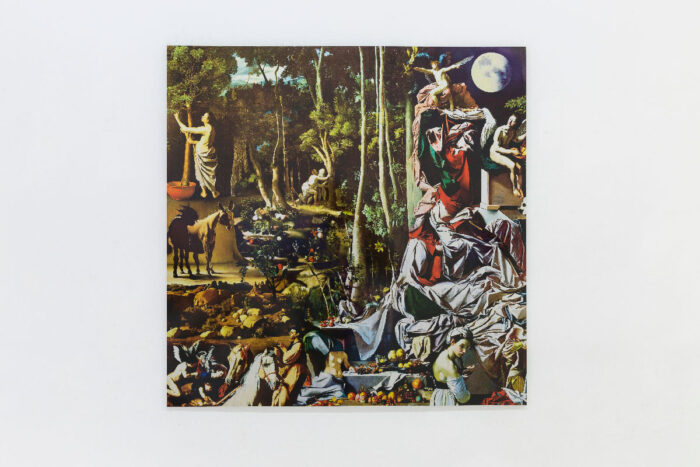
This is an image made from hundreds of AI prompts collaged together. It is an image which thinks the collapsing destiny of truthmaking by sight, the crisis of images that tell the truth, and it has been made asking an open-source software to reproduce the painting style of Michelangelo Merisi. I will say nothing about its parts, but we can discuss the general problem. Caravaggio’s ability in forming representations populated by people recognizable as people and not as ideas of people was considered by many of its contemporaries as a direct attack to Art itself. Poussin accused him of «destroying painting». Why? Caravaggio would refuse to accept the Classical tenet of slicing and reassembling parts of reality to create a bettered and perfected one inside the space of the representation, he would operate differently, apparently inserting slices taken from the too human and faulty everyday. Was Caravaggio the first Modernist artist? Dürer named his naturalistic drawings of animals «counterfeit images». Dürer’s photographic rabbit was a rabbit, not the idea of a rabbit. A visual style that was counterfeiting and fake in the time of Dürer is realistic to us thanks to Caravaggio and despite Plato. Then we had two hundred years of photography. Today, the quick advancement of generative imaging is questioning the truth-making role we attribute to the phenomena we understand as photographic or filmic. The FBI and NATO have published on this topic, google it. Is the AI attacking Modernism? In the end, with my painting the point was to have fun with the Caravaggio style as it was learned by a software instructed by a web-crawler which scraped the web and compiled a database. Since this AI interpolates vast amount of non-curated data, the images linked to the tag /caravaggio/ might refer not only to the Old Master and they might have or not have a good quality. This was evident in the process of making this thing when, many times, I had to work hard to fix certain areas of the image that would appear as reproducing not much Caravaggio’s style, but rather the flaws visible in the freely accessible photographs of his paintings. Which flaws? What happens when a non-professional takes a picture of a painting? In most cases, the picture will incorrectly reproduce some areas of the surface because of its reflecting properties: some light will bounce and cause a blurry white hole, fabricating a false representation. As the freely accessible internet is full of non-professional photographs of Old Masters paintings, the artificial “intelligence” (which is an hyperrealist) considers these glitches as part of the style of the artist and will try at some point to render them. For the time being, the “intelligent” agents cannot deal with simple contextual situations that humans can easily understand and interpret.
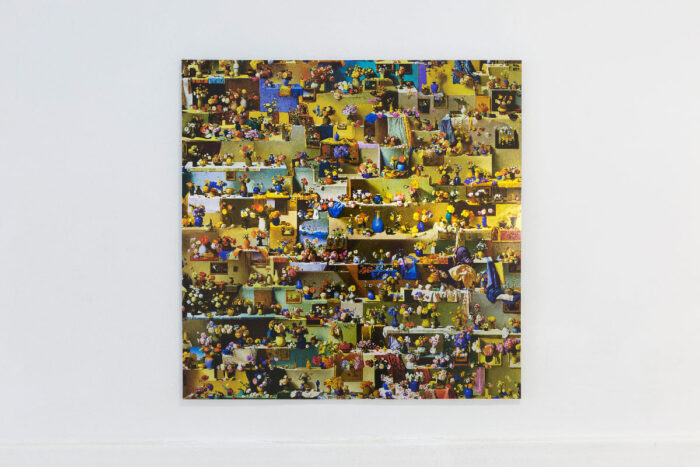
Determined to pursue my point, I continued my experiments in another direction, taking over the style of another champion of realism, Johannes Vermeer. In this case I used a different technique, employing the same exact prompt for more than a thousand times. I got something that stands in between a lace and Super Mario. Why do we see an ever-differentiating composition? The mathematical procedure of the generative algorithms is comparable to sculpting a piece of white marble. Initially, there is a neutral meaningless form, an image composed of noise: the values of each pixel are casual, x amount of R, y amount of G, z amount of B. From here, the algorithm iterates itself, progressively approaching what it understands as the meaning of the prompt. Chance takes over. This process resembles scoring an ambient piece. A central theme is taken and expanded as much as possible, eventually towards infinity. The patience and availability of the artist are the only limits given to the music. But please remember: Vermeer never painted flowers.
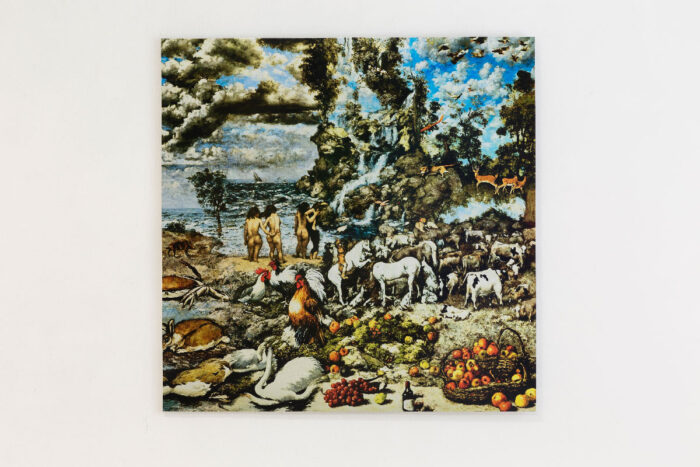
In this third instance I appropriated Gustave Courbet’s style. Another champion of realism, a hunter and anarchocommunist, Courbet would directly challenge photography, an emergent technology at his times. It is known that to achieve his compositions he would use photographs, or he would appropriate vedutas taken by professional photographers. Today Courbet is remembered because he strove not to be outdated by gadgets and rather took advantage of the new technical configuration of the world he was facing. I found out that Courbet’s brush technique is among the most interesting ones to evoke with AI. While the AI hi-fi aesthetics is very boring, exploiting the pre-impressionist style of Courbet conveys remarkable images. If we look at them from a certain distance, they are vibrant and powerful. If we inspect them closely, we will discover only inconsistencies and abstractions.
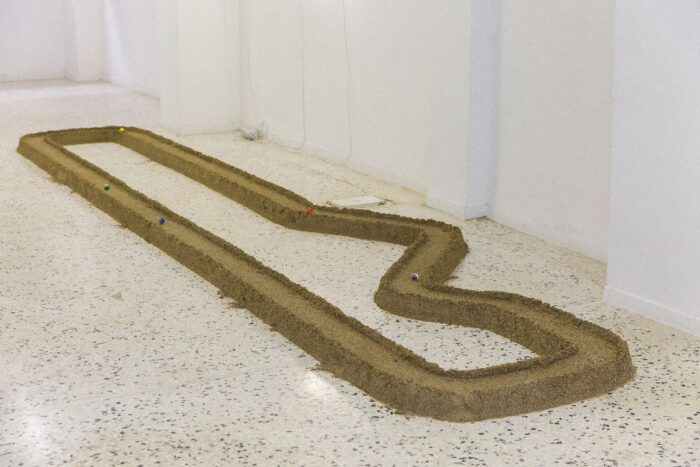
There is also this circuit made of sand. Instead of electrical signals, it is populated by little plastic marbles. Inside the balls one will find portraits of philosophers. You can play with the sculpture: four people take four balls and place them on the starting line, then, in turn, they hit them with their middle finger pushing them as forward as possible. Who arrives first? Different philosophical traditions try to take over language and orient history. A strange game. Somebody wins, somebody lose. Does it mean anything? Instead of being hit by the philosophers, it is the players who knock these felons on their heads. Please be careful because the circuit might get destroyed.
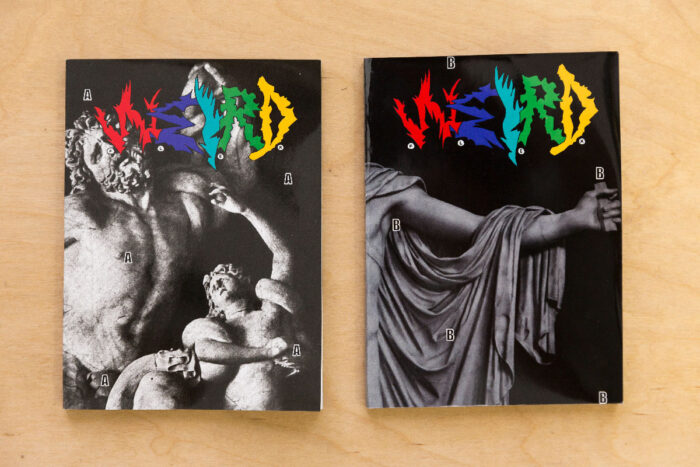
This exhibition has its own bookshop. I had this idea to make a book with memes. The memes come mostly from my feed and are saved in a special folder from which I choose those that will compose the final edit. It is an eerie montage, a curated feed. It is an archive of puzzles for the iconologists of the future. See you in 500 years, fuckers. All the available sources and upload dates are reported in the index. Sometimes it is possible to say who created the memes, sometimes not. Ahahah. The books invent a truthful epistemology of the contemporary. At the intersection of tragedy and comedy, WEIRD FLEX covers a certain span of time: from late 2020 to early 2022 (vol. I) and from early 2022 to early 2023 (vol. II). Dante’s Commedia stretched between the farts of the devils and the voice of the angels; on its part, WEIRD FLEX comes in 50 copies, introduced by this beautiful poem written by my friend Enrico Camporesi:
ἡμἐ(μἐ)ρα
A journal without subject,
meaning a writing “I”,
would resemble the button
I click on as I rub my eyes
A theory for pockets
in print, no less!
no USB sockets
now that’s a weird flex
